
Nuño Beltrán de Guzmán was a Spanish conquistador and colonial administrator in New Spain. He was the governor of the province of Pánuco from 1525 to 1533 and of Nueva Galicia from 1529 to 1534, and president of the first Royal Audiencia of Mexico – the high court that governed New Spain – from 1528 to 1530. He founded several cities in Northwestern Mexico, including Guadalajara.
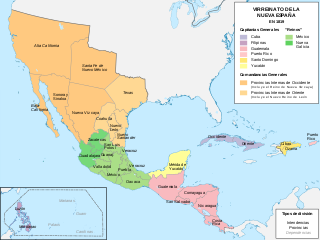
Nueva Vizcaya was the first province in the north of New Spain to be explored and settled by the Spanish. It consisted mostly of the area which is today the states of Chihuahua and Durango and the southwest of Coahuila in Mexico.
La Gran Chichimeca was a term used by the Spanish conquistadores of the 16th century to refer to an area of the northern central Mexican altiplano (plateau), a territory which today is encompassed by the modern Mexican states of Jalisco, Aguascalientes, Nayarit, Guanajuato, Queretaro, and Zacatecas. They derived the term from the Aztec who referred to the nomadic tribes of the area as “chichimeca”.

The Caxcan are an ethnic group who are indigenous to western and north-central Mexico, particularly the regions corresponding to modern-day Zacatecas, southern Durango, Jalisco, Colima, Aguascalientes, Nayarit. The Caxcan language is most often documented as an ancient variant of Nahuatl and is a member of the Uto-Aztecan language family. The last generation of natively fluent Caxcan language speakers came to an end in the 1890s. Despite this having long been conflated by anthropologists with an extinction of the Caxcan people themselves, much of Caxcan culture has persisted via oral tradition. There is currently an ongoing revitalization of Caxcan language, scholarship, and culture.
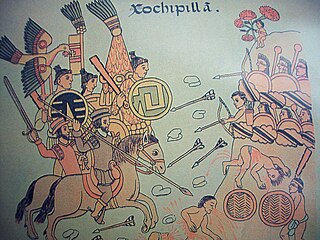
The Mixtón War (1540-1542) was a rebellion by the Caxcan people of northwestern Mexico against the Spanish conquerors. The war was named after Mixtón, a hill in Zacatecas which served as an Indigenous stronghold.
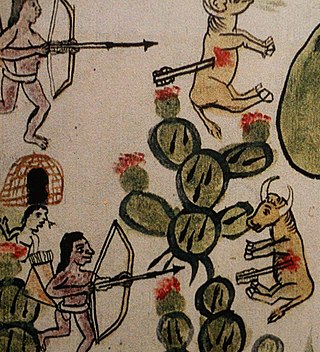
The Chichimeca War (1550–90) was a military conflict between the Spanish Empire and the Chichimeca Confederation established in the territories today known as the Central Mexican Plateau, called by the Conquistadores La Gran Chichimeca. The epicenter of the hostilities was the region now called the Bajío. The Chichimeca War is recorded as the longest and most expensive military campaign confronting the Spanish Empire and indigenous people in Aridoamerica. The forty-year conflict was settled through several peace treaties driven by the Spaniards which led to the pacification and, ultimately, the streamlined integration of the native populations into the New Spain society.
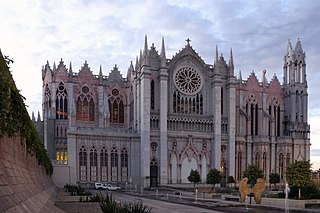
The Bajío is a cultural and geographical region within the central Mexican plateau which roughly spans from northwest of Mexico City to the main silver mines in the northern-central part of the country. This includes the states of Querétaro, Guanajuato, parts of Jalisco, Aguascalientes and parts of Zacatecas, San Luis Potosí and Michoacán.
Jalpa is a town located in the Mexican state of Zacatecas, close to the border with Jalisco and Aguascalientes and about a two hours drive south of the capital city, Zacatecas. Jalpa is a colonial-style city, with cobble stone streets, narrow walkways, two main churches: El Señor de Jalpa and La Parroquia de San Antonio, and two plazas. Jalpa was modeled by the French in the 19th century. In the middle of the plaza is a kiosk which remains in good shape today, after hundreds of years. Most houses are painted in bright colors just as in colonial times. The houses are made of adobe and share common walls and most have flat roofs.
Cristóbal de Oñate was a Spanish Basque explorer, conquistador and colonial official in New Spain. He is considered the founder of the contemporary city of Guadalajara in 1531, as well as other places in Nueva Galicia.
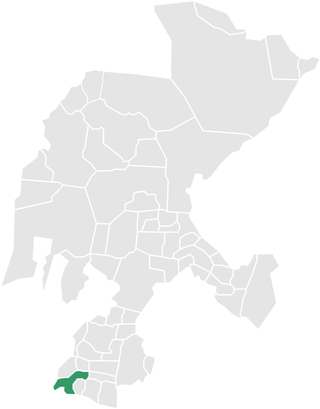
Teúl de González Ortega Municipality is a town and municipality located in the south of the Mexican state of Zacatecas, between the state capital of Zacatecas and the city of Guadalajara. Unlike most of the rest of the state, its economy has been based on agriculture and livestock, rather than mining, and it is noted for its production of agave and mezcal. The town has been named a Pueblo Mágico to promote a tourism industry.
The Real Audiencia of Mexico or Royal Audiencia of Mexico was the highest tribunal of the Spanish crown in the Kingdom of New Spain. The Audiencia was created by royal decree on December 13, 1527, and was seated in the viceregal capital of Mexico City. The First Audiencia was dissolved by the crown for its bungling and corruption and the crown established the Second Audiencia in 1530. This was supplanted by the Viceroyalty of New Spain in 1535. A new Audiencia was created in Guadalajara in western Mexico in 1548.
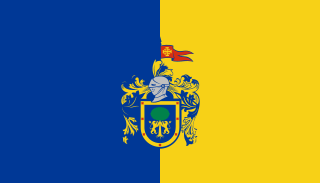
Jalisco, officially the Free and Sovereign State of Jalisco, is one of the 31 states which, along with Mexico City, comprise the 32 Federal Entities of Mexico. It is located in western Mexico and is bordered by six states, Nayarit, Zacatecas, Aguascalientes, Guanajuato, Michoacán, and Colima. Jalisco is divided into 125 municipalities, and its capital and largest city is Guadalajara.
The Real Audiencia of Guadalajara, was the highest tribunal of the Spanish crown in what is today northern Mexico and the southwestern United States in the Viceroyalty of New Spain. It was created by royal decree on February 13, 1548, and was originally located in Compostela and permanently seated in Guadalajara in 1560. Its president was the chief political and executive officer of the district, subordinated only to the Viceroy.

Zacatecas ( ), officially the Free and Sovereign State of Zacatecas, is one of the 31 states of Mexico. It is divided into 58 municipalities and its capital city is Zacatecas.

Francisco Tenamaztle, also Tenamaxtlan, Tenamaxtli or Tenamaxtle, was a leader of the Caxcan indigenous peoples in Mexico during the Mixtón War of 1540–1542. He was later put on trial in Spain. With the support of Bartolomé de las Casas he defended the justice of his cause by appealing to King Carlos I.

Huejúcar is a town and municipality, in Jalisco in central-western Mexico. The municipality covers an area of 309.2 km2.

San Cristóbal de la Barranca is a town and municipality, in Jalisco in central-western Mexico. The municipality covers an area of 523 km².

El Teúl is an important archaeological Mesoamerican site located on a hill with the same name in the municipality of Teúl in the south of the Mexican state of Zacatecas, near the border with the state of Jalisco.

Hernando Martel was a Spanish conquistador, judge, politician and military officer, born in Seville, Spain. He conquered and pacified much of the region known today as Lagos de Moreno.
Alonso de Ávalos Saavedra was a Castilian encomendero, explorer, conquistador, founder, captain, and mayor of Sayula.















